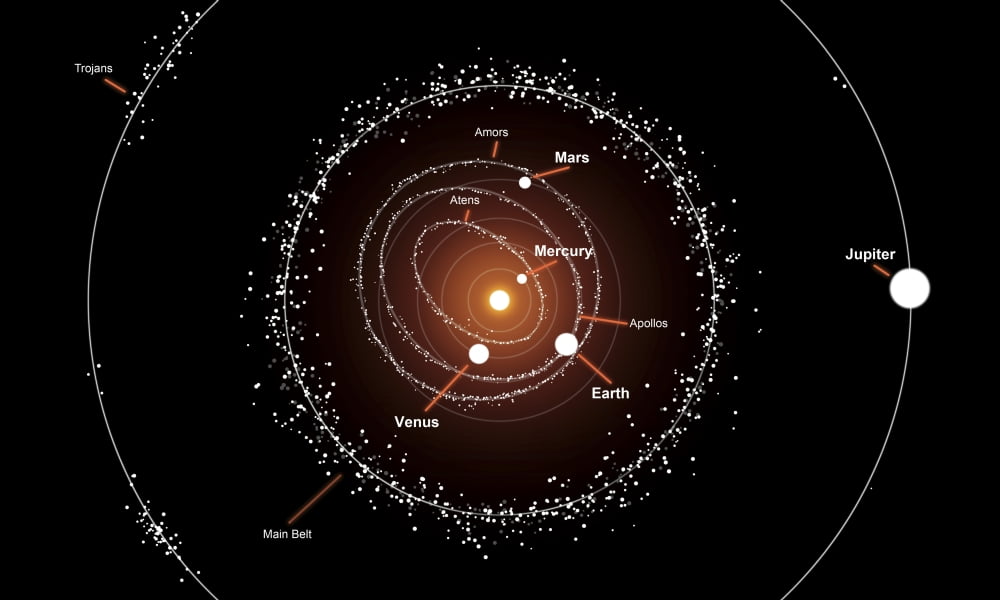Asteroids, sometimes called minor planets, are rocky, airless remnants left over from the early formation of our solar system about 4.6 billion years ago.
- Do Asteroids Revolve Around The Sun
- Most Asteroids Orbit The Sun
- Asteroid News
- Asteroids Orbit The Sun True Or False
- Asteroids Orbit The Sun
The current known asteroid count is: .
There are about 792,000 known asteroids that orbit the sun, according to the International Astronomical Union's Minor Planet Center, but only 21 (including 2020 AV2) are thought to orbit closer to. Astronomers have painstakingly built models of the asteroid population, and those models predict that there will be 1 km-sized asteroids that orbit closer to the sun than Venus does. The Asteroids Belt is billions of rocky objects which orbit the Sun between the inner and outer planets. Comets are made of ice and rock and orbit the Sun with highly eccentric orbits. But a new discovery has hinted that maybe there could be more asteroids in the 'Sun, planets' section. Perhaps even loads more. It's called 2019 AQ3 - an asteroid whose tight elliptical orbit is nearly always closer to the Sun than Venus, and even dips closer than Mercury.It takes just 165 days to orbit the Sun - the shortest year ever seen in a Solar System asteroid.
Most of this ancient space rubble can be found orbiting the Sun between Mars and Jupiter within the main asteroid belt. Asteroids range in size from Vesta — the largest at about 329 miles (530 kilometers) in diameter — to bodies that are less than 33 feet (10 meters) across. The total mass of all the asteroids combined is less than that of Earth's Moon.
Do Asteroids Revolve Around The Sun
Go farther.Explore Asteroids In Depth ›
Most Asteroids Orbit The Sun

Key Science Targets
Did You Know?Did You Know?
The total mass of all the asteroids in the main asteroid belt combined is less than that of Earth's Moon.
Kid-Friendly Asteroids
Kid-Friendly Asteroids
Asteroids are small, rocky objects that orbit the Sun. Although asteroids orbit the Sun like planets, they are much smaller than planets.
There are lots of asteroids in our solar system. Most of them live in the main asteroid belt—a region between the orbits of Mars and Jupiter.
Some asteroids go in front of and behind Jupiter. They are called Trojans. Asteroids that come close to Earth are called Near Earth Objects, NEOs for short. NASA keeps close watch on these asteroids.
Asteroid News
Asteroids are left over from the formation of our solar system.
Visit NASA Space Place for more kid-friendly facts.
Asteroids Orbit The Sun True Or False
NASA Space Place: All About Asteroids ›Resources
Additional Resources
What is in space? |
How do asteroids orbit?
Almost all of the asteroids in our solar system are orbiting in a broad band 19,400,000 miles wide between Jupiter and Mars. The asteroids are orbiting the Sun, each one traveling around the Sun fast enough for the orbits not to degrade. If something slows an asteroid, it may 'fall' towards the Sun, towards Mars, or towards Jupiter. As both Jupiter and Mars move past the asteroids in their orbits, they may be pulled slightly towards those huge bodies in their orbits. In fact, Phobos and Diemos, the two tiny moons of Mars, may be captured asteroids.
Mac os catalina patcher update. Image from the Solar System Dynamics Group of the Jet Propulsion Laboratory, Solar System Orbits Diagrams and Distribution Graphs Web Page, http://ssd.jpl.nasa.gov/orbit_diagrams.html.
Some scientists believe that the asteroid belt was made when a planet that was there exploded or collided with something else and broke up. Other scientists believe that the material making the asteroids never came together into a planet at all.
The chart below shows how asteroids compare to each other in terms of how far they are from the Sun (semi major axis) and what the shape of their orbit is. Just like many other bodies in the solar system, the orbits made by asteroids are not perfect circles, but ellipses. The axis marked eccentricity is a measure of how far from circular each orbit is. The smaller the eccentricity number is, the more circular the orbit is.
Asteroids Orbit The Sun
Image from the Solar System Dynamics Group of the Jet Propulsion Laboratory, Solar System Orbits Diagrams and Distribution Graphs Web Page, http://ssd.jpl.nasa.gov/orbit_diagrams.html.
What is an asteroid, a planetoid, a meteoroid a micrometeoroid?
What is in space besides planets and stars?
What is an orbit?
What causes an orbit to happen?
What travels in an orbit?

How is an ellipse different from a circle?
What is the orbital plane?
Are there orbits within orbits?
How do we know what's in space?
What are the orbital lengthsand distances of objects in our solar system?
